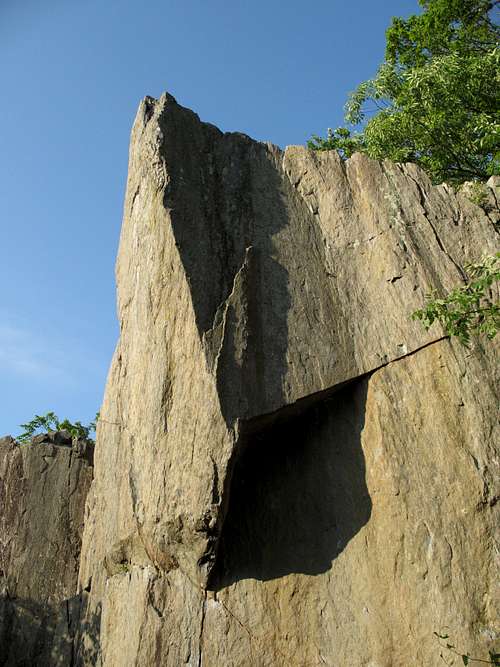-
 11107 Hits
11107 Hits
-
 81.17% Score
81.17% Score
-
 13 Votes
13 Votes
|
|
Mountain/Rock |
|---|---|
|
|
38.99070°N / 77.2485°W |
|
|
Trad Climbing, Toprope |
|
|
Spring, Summer, Fall, Winter |
|
|
144 ft / 44 m |
|
|
Overview and Routes
Perhaps the most striking of the named Great Falls climbing crags, Aid Box is one of the hardest climbing spots in the park, with the easiest established routes beginning at 5.5 and the hardest getting up to 5.13. The crag itself is distinguished by its prominent "nose" that is best seen and appreciated from below and just upstream of the crag, though it is noticeable from the River Trail above, which helps hikers and climbers find this spot. Aid Box is a small amphitheater that faces the river but is not directly over it, so if you fall, you can break your bones on the hard rock instead of drowning in the treacherous Potomac River. Toproping is the climbing style most common at Great Falls. Most routes really aren't suitable for leading, especially considering the ban on fixing permanent bolts, but some routes can be led (and are). At Aid Box, it is recommended that you bring equipment for setting up a toprope; although I've never met others here on my visits, the crag is supposedly one of the most popular at Great Falls, and the best natural setups may be taken by the time you arrive. The climbs here only range from 25 to 40 feet, and most have just a single pitch, but they are hard. SP's best climbers would probably like this area the most of the Great Falls climbing crags I have put up on the site thus far. All the photos on this page have captions that provide useful directional or route information. Please click on them to access that information. If you have climbed or do climb any of the routes listed on this page, or any that aren’t, please add a route page or supply an overview in Additions (I will add it to the main page). A selection of the established routes on Aid Box, from upstream to downstream: • P.V. Wall (5.12a/b)—about 10 feet right of the overhang on the upstream face, climb the face (not the crack to the right). • P.V.O. (5.12b/c)—Potomac Valley Overhang. On the upstream face, climb a thin crack that takes you under the left side of the overhang. Then pull through that left side with what guidebook author Eric Horst calls “body-wrenching moves” and finish straight up. • The Strain (5.12c)—Begin on either P.V.O. or Lost Arrow to access the incipient crack running vertically between them. Then head up. • Lost Arrow (5.10c)—a pin-scarred crack and a left-facing corner finish just left of the “nose.” Area classic. People will sit around and wait for this one. • Splinters (5.7)—starts below a small overhang, goes along the right-facing corner. • The Box (5.5)—a large, right-facing corner near the middle of the Aid Box wall; might be suitable for good free soloists, but getting up into the corner itself is very tricky. • Diagonal (5.9-)—climb the first 15 feet of The Box, which takes you to the base of the corner, and then follow the diagonally running crack along the left wall. • Monkey Fingers (5.12a/b)—Start about 15 feet left of the corner of The Box and climb the “thin, desperate crack.” • Dark Corner (5.6)—an obvious corner about 15 feet left of Monkey Fingers. • Skid Row (5.9)—About 5 feet left of Dark Corner’s namesake, on an upstream-facing wall, climb up a few feet and then move left in the direction of the edge and follow a crack and flake. Many of these routes are listed in the local guidebook as being among the best Great Falls has to offer.
•Scrambling—not much on the crag itself, but some. Near the left end, below the upstream-facing wall, look for a narrow ramp offering an easy way around to the river-facing side. Break out on a shelf with a nice view of the river and the cliffs across it. The scrambling opportunities on Aid Box proper are here. To the left, they are easier and Class 3. To the right, they get into Class 4. One of them, pictured in this page's gallery, leads to the top of one of Aid Box’s pinnacles and provides a spectacular view upstream of the “nose,” Little Aid Box, and the Romeo’s Ladder/Seclusion area.





